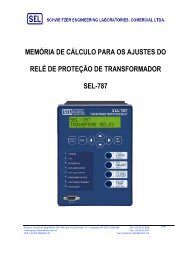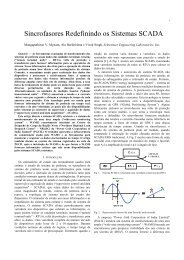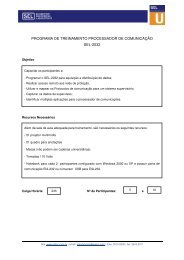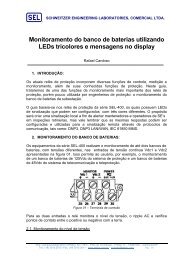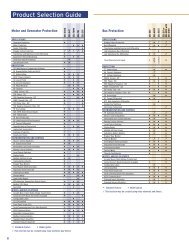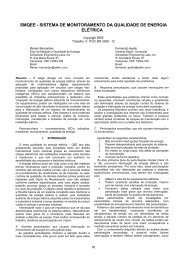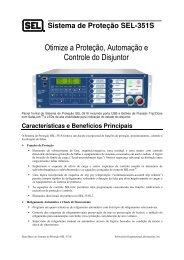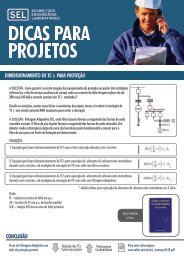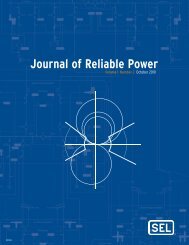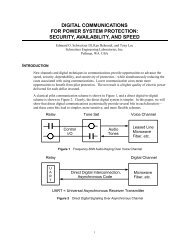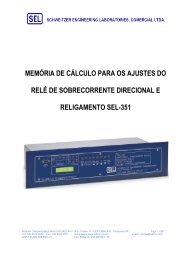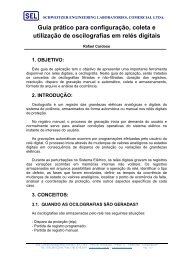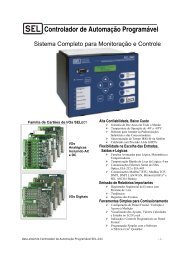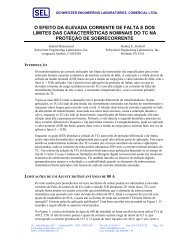Journal of Reliable Power - SEL
Journal of Reliable Power - SEL
Journal of Reliable Power - SEL
Create successful ePaper yourself
Turn your PDF publications into a flip-book with our unique Google optimized e-Paper software.
11<br />
m<br />
2<br />
1.5<br />
1<br />
0.5<br />
0<br />
3 4 5 6 7 8 9 10 11<br />
Cycles<br />
Fig. 29. Directional Element Response With CT Tap Lower Than CTR<br />
Setting<br />
It is suspected that the CTR setting in the relay does not<br />
match the actual CT tap in the field. However, this is part <strong>of</strong><br />
an ongoing investigation and, at the time <strong>of</strong> publication, root<br />
cause is yet to be determined.<br />
XI. DIRECTIONAL ELEMENT AFFECTS CARRIER EXTENSION<br />
In June 2006, a 161 kV line tripped incorrectly for a<br />
reverse AG fault. The line was protected by a DCB scheme.<br />
The ground directional element used the best choice logic<br />
described in Section IX. The element used ground current<br />
polarization first (I), followed by zero-sequence voltage<br />
polarization (V), and then by negative-sequence voltage<br />
polarization (Q).<br />
The event data from the misoperation are shown in Fig. 30.<br />
For a reverse fault, we expect the polarizing current (IP) and<br />
the terminal ground current (IG) to be 180 degrees out <strong>of</strong><br />
phase. In the event data, however, IP and IG were in phase. A<br />
wiring error was found; the polarizing current CT was<br />
connected reverse polarity. This allowed the local breaker to<br />
trip.<br />
IA IB IC<br />
VA(kV) VB(kV) VC(kV)<br />
IP IG<br />
Digitals<br />
1000<br />
0<br />
-1000<br />
100<br />
0<br />
-100<br />
5000<br />
0<br />
-5000<br />
DSTRT<br />
Z3XT<br />
50G3<br />
32QR<br />
F32I<br />
67G1T<br />
IA IB IC VA(kV) VB(kV) VC(kV) IP IG<br />
2 3 4 5 6 7 8<br />
Cycles<br />
Fig. 30. Directional Element Misoperation due to IP Wiring Mistake<br />
The remote breakers were allowed to trip because <strong>of</strong> the<br />
carrier-blocking signal dropout as the breaker was interrupting<br />
the fault. In Fig. 31, directional carrier blocking (DSTRT) was<br />
asserted due to a negative-sequence element (50Q3) and a<br />
negative-sequence directional element (R32Q). At the end <strong>of</strong><br />
the event, the DSTRT element chattered then dropped out.<br />
This was because <strong>of</strong> the phase angle error introduced by<br />
arcing during interruption. Carrier blocking extension is<br />
enabled in this relay but requires Zone 3 elements to be<br />
asserted for 2 cycles; they were only asserted for 1.5 cycles.<br />
During the investigation, it was noted that the directional<br />
element processing order <strong>of</strong> IVQ was not typically used by<br />
this utility; an order setting <strong>of</strong> QV was more common. Would<br />
carrier extension have asserted if we had used the typical<br />
order<br />
In Fig. 31, the ground-polarized directional elements (F32I<br />
and 32GF) assert because <strong>of</strong> the directional logic order and<br />
wiring error. The phase angle <strong>of</strong> the faulted phase current<br />
varies wildly during the beginning <strong>of</strong> the fault because <strong>of</strong> the<br />
fault arcing and evolution. This delays the voltage-based<br />
directional elements but has little effect on the current-based<br />
directional element. Also in Fig. 31, negative-sequence<br />
directional elements (32QR and R32Q) asserted later in the<br />
fault. 32QR and R32Q supervise phase distance and negativesequence<br />
overcurrent elements. Their ground logic equivalent<br />
(R32QG) is controlled by best choice logic. R32QG did not<br />
assert because the IP-based element has priority, but the<br />
directional decision it would make would match that <strong>of</strong> 32QR<br />
and R32Q when enabled. From this, we realize that the order<br />
and best choice logic processing did not delay the R32QG<br />
element; the evolving fault did.<br />
IA IB IC<br />
VA(kV) VB(kV) VC(kV)<br />
Digitals<br />
1000<br />
0<br />
-1000<br />
100<br />
0<br />
-100<br />
50Q3<br />
50G3<br />
NSTRT<br />
DSTRT<br />
Z3XT<br />
R32V<br />
F32V<br />
R32QG<br />
F32QG<br />
R32Q<br />
F32Q<br />
R32I<br />
F32I<br />
32QE<br />
32IE<br />
32QGE<br />
32VE<br />
32GR<br />
32GF<br />
32QR<br />
IA IB IC VA(kV) VB(kV) VC(kV)<br />
0.0 2.5 5.0 7.5 10.0 12.5 15.0<br />
Cycles<br />
Fig. 31. Detailed Relay Response to Fault<br />
The evolving fault should delay a directional decision for<br />
all the relays. Remote relays additionally include a carrier<br />
coordination delay for tripping. How fast the directional<br />
element sent blocking is not the real issue in this fault; it is<br />
how fast we enable carrier extension. Setting the carrier<br />
extension pickup delay (Z3XPU) to a lower value, even zero,<br />
is recommended [13].<br />
XII. COMPARING PRIMARY AND BACKUP METERING<br />
In November 2005, a 138 kV transmission line experienced<br />
an AG fault. The backup relay correctly saw the fault as<br />
forward and tripped by the directional ground overcurrent<br />
element (67G1). The primary relay, however, declared a<br />
reverse fault and did not operate.<br />
62 | <strong>Journal</strong> <strong>of</strong> <strong>Reliable</strong> <strong>Power</strong>



